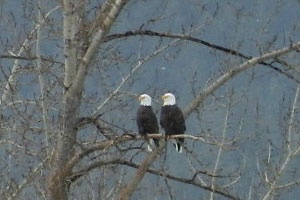Winter Raptors

Two Bald Eagles along the Wenatchee River.
When to go:
December, January, February
Where to go:
What to look for:
Winter is a great time to look for raptors because all the trees have lost their leaves, making the birds easy to spot.
Plus, many birds migrate here for the winter. Even species that are here year-round, like Bald Eagles, will be more plentiful because of all the visiting individuals.
Four special species that are only here during the winter are the Snowy Owl, the Merlin, the Rough-legged hawk and the Gyrfalcon. These raptors breed in the far north, and come here for our comparatively mild winter weather.
-
Snowy Owl
 The Snowy owl is big, spectacular, and easy to recognize. It is the biggest owl (by weight) in North America. They are white all over with black markings. They have big yellow eyes and no ear tufts.
The Snowy owl is big, spectacular, and easy to recognize. It is the biggest owl (by weight) in North America. They are white all over with black markings. They have big yellow eyes and no ear tufts.If there is one around, it will be on the rare bird alerts. If there are a lot around, they'll likely be on the local news.
Snowy owls breed in the Arctic and head south for the winter. In a good year, some will make it all the way down into Washington. Look for them in cut farm fields or perched on fenceposts and other low objects - these are tundra birds, and they don't like trees.
It isn't likely that you'll hear a Snowy owl, but if you do it will sound like a squeaky hiccuping cough.
-
Merlin
 The Merlin is a small falcon that may arrive in the fall and stay until late spring. A few may even stay to nest, but winter is the best time of year to look for them. They are about the size of a pigeon, with pointed wings and a long, banded tail. Their call is a high-pitched repetative kee-kee-kee.
The Merlin is a small falcon that may arrive in the fall and stay until late spring. A few may even stay to nest, but winter is the best time of year to look for them. They are about the size of a pigeon, with pointed wings and a long, banded tail. Their call is a high-pitched repetative kee-kee-kee.Merlins hunt other birds, catching them in midair. Watch for them perched in bare trees or on utility poles, waiting for prey to fly by beneath them.
-
Rough-legged hawk
 The Rough-legged hawk is a big hawk with white at the base of the tail and a dark tail-tip. They have a black wrist-patch, and the trailing edges of the wings are also dark.
The Rough-legged hawk is a big hawk with white at the base of the tail and a dark tail-tip. They have a black wrist-patch, and the trailing edges of the wings are also dark.Unlike the Red-tailed hawk, the Rough-legged hawk has feathered legs. They eat small birds and rodents and like to perch on fence posts and utility poles near open fields. Their call is a descending aaaaahh! note.
Like the Snowy owl, the Rough-legged hawk is a true winter visitor. In the spring they return to the Arctic to breed.
-
Gyrfalcon
 The Gyrfalcon is the largest falcon in the world - it has a wingspan of four feet. Most often they are grey with darker barring, but some can be pure white or black.
The Gyrfalcon is the largest falcon in the world - it has a wingspan of four feet. Most often they are grey with darker barring, but some can be pure white or black.
Gyrfalcons eat other birds. On the tundra they prefer ptarmigan, but they will eat ducks, geese, gulls and even other hawks!
If a Gyrfalcon is in the area, it will be on all the rare bird alerts - they are a big deal when they come this far south.
What is a raptor?
Raptors are birds of prey, and birds of prey are predators. However, many birds that are predators are not birds of prey.
Loons and pelicans eat fish and are definitely predators, but they don't have a hooked beak or talons like a raptor does. Only two groups of birds are considered raptors: Owls and Hawks.
Owls are easy - they are all called owls and everyone knows what an owl looks like.
Hawks are a little more difficult. This group includes hawks, eagles, falcons, kites, harriers and more. These birds are varied in appearance, but they all have the beak and talons of a raptor.
Vultures are not technically raptors (they are more closely related to storks, believe it or not), but since they look so much like hawks they are often put next to the raptors in bird books.
Sources:
The Cornell Lab of Ornithology All About Birds, 2012
The Cornell Lab of Ornithology Macaulay Library, 2012
The Northwest Nature Guide, Timber Press 2009
Peterson Field Guide to Birds of Western North America, Houghton Mifflin Harcourt 2010
Images by Molly Kent
